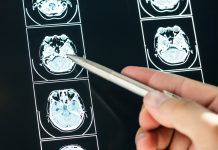
One hot day last June, Elmar Uy and his girlfriend, LJ Jennings, were gardening outside their home in Hudson, New Hampshire, when something strange happened. Everywhere Uy looked, he saw crescent-shaped spots.
Jennings thought Uy might be dehydrated. She got him some water.
Over the next few days, Uy’s eyes became sensitive to light. He had headaches. He thought it might be an ocular migraine. He took to staying in dark rooms at home to avoid bright light.
Uy saw a neurologist who specializes in headaches. The doctor ordered several tests. Uy was still waiting for some results when July Fourth weekend rolled around.
He happily gathered with his sons, Junior and Brandon, and their kids at the family’s holiday home in the Berkshires in western Massachusetts.
Jennings was working and stayed in New Hampshire. After unpacking, the family caught up over chicken wings. At the kitchen sink, Elmar washed a glass for a drink. His eldest son, Junior, was by his side, ready to pour.
Elmar wanted to move his feet. When he looked down, they were moving but he couldn’t feel them. He sat on a bench in the kitchen and told Junior to call 911.
When the ambulance got there, Elmar was able to walk outside. In the ER, with both eyes open, Elmar’s right eye vision shifted eight inches. He saw double. He pushed the panic button.
Doctors gave him medicine and his vision improved. They moved him to a critical care coronary unit, where years earlier his mother had worked as a charge nurse.
Elmar passed a series of neurological tests including following the doctor’s finger and closing his eyes and touching his nose. He felt fine.
Over four days, he had blood work, an ultrasound of his heart and a brain scan. The results of the scan showed a handful of white dots.
Dead spots, the doctor told him. From his hospital bed he listened to the Fourth of July fireworks.
Elmar had experienced an ischemic stroke, which happens when a blood vessel that supplies the brain gets blocked.
It happened in the back of his brain in an area in charge of mobility and vision. But doctors couldn’t pinpoint an exact cause for the stroke.
At the same time, the neurologist Elmar saw in June finally called with results of the imaging recently done. It, too, spotted the blockage.
Elmar started medication to lower his cholesterol and help prevent another stroke. During the three-hour drive home, he was petrified he might have another stroke.
Elmar, a 57-year-old former Marine, had led an active lifestyle, doing cardio boxing twice a week. After the stroke, he began his recovery by walking. A mile took him 40 minutes and left him tired.
“Maybe in the back of my mind I didn’t want to push my heart,” he said. “I was more traumatized than anything the stroke did to me.”
He changed his diet from frequent servings of fatty pork and white rice from his Filipino heritage to oats for breakfast and salads for lunch. Jennings made him kale chips and roasted vegetables. He stopped using tobacco.
A month after his stroke, Elmar and Jennings were on a walk when he couldn’t catch his breath. His heart raced.
At home, the crescent-shaped spots reappeared. Panic set in. They called 911. It could be plaque that broke loose, doctors said in the ER.
Elmar received an implantable loop recorder, a device that provides constant monitoring for abnormal heart rhythms. Doctors upped the doses of his medications.
As he approaches the first anniversary of his stroke, Elmar’s body has recovered but his emotions are still frayed. He thinks in worst-case scenarios.
He’s hypervigilant about any abnormal feeling in his body – a tight neck, a sore muscle, excessive fatigue.
During errands, he’s often overcome with anxiety and wants to rush home. So he gets his daily steps inside at home.
His heart races to think he may not be around to see his grandchildren grow up.
“I’m in my head constantly,” he said. “The hardest part is the mental piece.”
When news broke in February that Pennsylvania Sen. John Fetterman, who had a stroke last May, was getting treated for depression, Elmar realized how much he related to Fetterman’s story.
“You feel so hopeless sometimes and you can’t just snap out of it or be happy,” Elmar said.
He found the American Heart Association Support Network and shared his story. Then, he wrote a 5,000-word account of his experience.
“I’m depressed feeling hopeless that I won’t make it through this year,” he wrote. “Yet, I put on a brave outward face that makes me look OK and sound OK. I am not OK.”
Writing it felt “therapeutic” for Elmar. It also helped his friends and family understand his struggles.
“I didn’t know how depressed he was until I read it,” said Jennings, his girlfriend. “I can feel that he’s afraid and it’s definitely changed our lives.”
Elmar and Jennings are hopeful that counseling will help. He plans to see a therapist at his local veterans hospital. The couple also are considering finding a local support group and a Bible study group.
In the meantime, Elmar leans on advice from a therapist he saw years ago as part of his Marine Corps discharge. When he can’t control his thoughts or dark thoughts dominate, he asks himself the time and where he is.
“The answer is always, ‘It is now and I am here,'” he said. “It immediately grounds you.”
Written by Deborah Lynn Blumberg.
If you care about stroke, please read studies about a major cause of stroke, and MIND diet could slow down cognitive decline after stroke.
For more information about health, please see recent studies about how Mediterranean diet could protect your brain health, and this exercise can help you sleep better.



